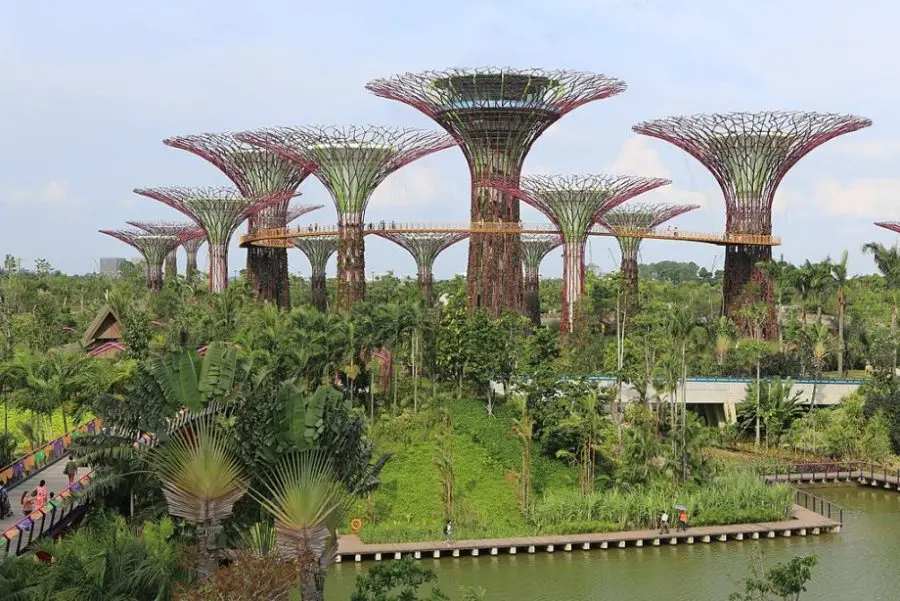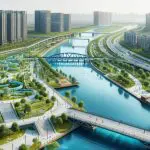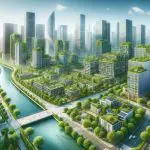
Explore the benefits of blue-green infrastructure! Discover how it transforms urban areas into healthier, more sustainable spaces.
Benefits of Blue-Green Infrastructure
Key Takeaways:
- Benefits of Blue-Green Infrastructure include:
- Improved air and water quality
- Reduced urban heat island effect
- Enhanced biodiversity
- Better stormwater management.
- They also boost mental health, increase property values, and provide recreational spaces in urban areas.
Explore the transformative potential of Blue-Green Infrastructure (BGI) in urban areas. Delve into how green roofs, rain gardens, and permeable pavements are revolutionizing urban spaces, offering a myriad of benefits from improved air quality to enhanced mental health.
1. Understanding Blue-Green Infrastructure
Blue-Green Infrastructure (BGI) represents an innovative approach to urban planning, combining natural systems with urban development.
It encompasses both ‘green’ elements, like parks and gardens, and ‘blue’ elements, such as water bodies and wetlands.
BGI plays a crucial role in sustainable urban planning, addressing environmental challenges while enhancing urban spaces’ livability and resilience.
It’s a strategic shift from traditional grey infrastructure, focusing on integrating nature into urban environments to solve multiple problems, ranging from stormwater management to improving public health.
The Blend of Green Roofs, Urban Gardens, and Permeable Pavements
Green roofs, urban gardens, and permeable pavements are fundamental components of BGI.
These elements work in harmony to create a more sustainable and livable urban environment.
- Green Roofs: These are vegetated layers installed on rooftops, offering benefits like reducing the urban heat island effect, improving air quality, and providing recreational spaces. They also play a role in stormwater management by absorbing rainwater.
- Urban Gardens: These spaces, whether in the form of community gardens or vertical gardens, bring greenery into urban areas, contributing to biodiversity, air quality improvement, and social interaction.
- Permeable Pavements: Designed to allow water to pass through and be absorbed into the ground, these pavements reduce surface runoff, mitigate flooding, and recharge groundwater.
Role in Climate Adaptation and Urban Resilience
BGI is pivotal in adapting urban areas to climate change and enhancing their resilience.
These systems offer a buffer against extreme weather events, like heavy rainfall and heat waves, by utilizing natural processes.
For instance, green spaces can lower surface temperatures in cities, reducing the heat island effect.
Similarly, wetlands and permeable surfaces can significantly reduce the risk of urban flooding by absorbing excess rainwater, thereby protecting urban infrastructure and populations.
Table: Key Components of BGI and Their Functions
| Component | Function |
|---|---|
| Green Roofs | Temperature regulation, air purification, stormwater management |
| Urban Gardens | Biodiversity, social well-being, air quality improvement |
| Permeable Pavements | Flood mitigation, groundwater recharge, pollution reduction |
| Wetlands | Flood control, water filtration, habitat provision |
| Urban Trees | Carbon sequestration, shade provision, air quality improvement |
| Water Bodies (Lakes, Rivers, Ponds) | Ecosystem support, recreational space, temperature moderation |
In a Nutshell:
By integrating these components, BGI creates multifunctional urban spaces that not only address environmental and climatic challenges but also improve the quality of life for urban residents.
This approach to urban infrastructure marks a significant shift towards more sustainable and resilient urban development.
2. Environmental Benefits: From Air Quality to Water Cycle Management
Blue-Green Infrastructure (BGI) is a cornerstone in promoting environmental sustainability in urban areas.
By integrating natural elements into the urban fabric, BGI offers a range of environmental benefits.
These include enhancing air quality, managing the water cycle, and mitigating the effects of urban heat islands.
BGI not only supports biodiversity and provides habitats for various species but also plays a significant role in carbon sequestration and climate change mitigation.
Role in Improving Air Quality and Managing the Water Cycle
BGI significantly improves air quality in urban environments.
Air Quality
Trees and plants in green roofs and urban gardens act as natural air filters, absorbing pollutants like nitrogen dioxide and particulate matter.
This natural filtration contributes to a healthier urban atmosphere, reducing the risk of respiratory diseases among city dwellers.
Water Cycle Management
In terms of water cycle management, BGI components like rain gardens, permeable pavements, and wetlands play a crucial role.
They help in groundwater recharge and reduce the strain on sewer systems by managing stormwater runoff.
By allowing water to infiltrate the ground, these elements prevent flash flooding and contribute to maintaining the natural water cycle in urban areas.
Impact on Urban Heat Island Effects and Stormwater Runoff
The urban heat island effect, characterized by higher temperatures in urban areas compared to their rural surroundings, is significantly mitigated by BGI.
Green spaces and water bodies provide cooling effects, reducing surface and air temperatures.
This not only makes urban areas more comfortable but also reduces the energy consumption associated with air conditioning.
BGI also effectively manages stormwater runoff, a major challenge in urban areas with impermeable surfaces.
Features like bioswales, rain gardens, and green roofs absorb and filter rainwater, reducing the burden on traditional drainage systems and preventing urban flooding.
Table: Comparative Analysis of BGI vs Traditional Grey Infrastructure
| Feature | BGI Benefits | Traditional Grey Infrastructure |
|---|---|---|
| Air Quality | Improves by filtering pollutants | Little to no impact on air quality |
| Water Cycle Management | Enhances groundwater recharge, reduces runoff | Often leads to increased runoff and flooding |
| Urban Heat Island Effect | Reduces temperatures through shading and evapotranspiration | Contributes to higher urban temperatures |
| Biodiversity | Supports diverse ecosystems | Limited support for biodiversity |
| Carbon Sequestration | High potential through vegetation | No carbon sequestration |
| Cost-Effectiveness | Long-term cost savings in maintenance and energy consumption | High maintenance and operational costs |
| Aesthetic and Recreational Value | Enhances urban aesthetics and provides recreational spaces | Typically utilitarian with little aesthetic value |
In a Nutshell:
In summary, BGI offers a comprehensive approach to addressing environmental issues in urban settings, providing benefits that traditional grey infrastructure cannot match.
This approach not only helps in creating environmentally sustainable cities but also contributes to the overall well-being of urban populations.
3. Social and Economic Advantages: Enhancing Urban Life
Blue-Green Infrastructure (BGI) offers not just environmental but also significant social and economic benefits, greatly enhancing urban life.
By bringing natural elements into urban spaces, BGI fosters a healthier, more vibrant community life.
These benefits range from improved social cohesion and mental health to increased property values and economic opportunities.
Influence on Property Values and Quality of Life
BGI positively impacts property values. Urban areas with well-maintained green spaces, such as parks and green roofs, tend to have higher property values.
This is due to the increased desirability of living in areas with access to natural spaces.
Additionally, BGI contributes to a better quality of life by providing aesthetic beauty and recreational spaces, which are highly valued in urban settings.
Moreover, green spaces play a role in fostering community interactions and enhancing social cohesion.
They provide common areas where people can gather, interact, and participate in community activities, strengthening the social fabric of urban neighborhoods.
Contributions to Mental Health and Recreational Opportunities
The presence of natural elements in urban settings, a key component of BGI, has been linked to improved mental health.
Access to green spaces can reduce stress, anxiety, and depression.
Natural environments offer a respite from the urban hustle, allowing for relaxation and rejuvenation.
BGI also provides ample recreational opportunities.
Parks, greenways, and urban gardens offer spaces for physical activities like walking, jogging, and cycling, contributing to physical well-being.
They also serve as venues for community events and recreational activities, enhancing the cultural life of the city.
Table: Statistics on BGI’s Impact on Urban Communities
| Aspect | Impact | Statistics/Examples |
|---|---|---|
| Property Values | Increase in property prices | Properties near green spaces can see a value increase of up to 20% |
| Social Cohesion | Enhanced community interaction | Green spaces lead to 83% more social interactions |
| Mental Health | Improvement in mental well-being | Exposure to green spaces reduces stress levels by up to 28% |
| Physical Activity | Increase in physical activity | Access to green spaces leads to a 48% increase in physical activity levels |
| Recreational Opportunities | Enhanced community engagement | Urban parks host over 2.5 billion visits per year in the U.S. |
In a Nutshell:
In conclusion, the social and economic advantages of BGI are substantial, contributing to healthier, more connected, and economically vibrant urban communities.
The presence of natural elements within cities can transform urban spaces into more livable, desirable, and sustainable environments.
4. Case Studies: Examples from New York City and Beyond
Examining real-world examples of Blue-Green Infrastructure (BGI) provides valuable insights into its tangible impacts and benefits. From New York City’s pioneering initiatives to global efforts, these case studies illustrate how BGI can transform urban environments.
Analysis of New York City’s BGI Initiatives

New York City, known for its dense urban landscape, has made significant strides in implementing BGI.
One notable example is the High Line, an elevated linear park created on a former railroad spur.
This project has not only revitalized a disused space but also provided a green oasis in the heart of the city, improving air quality and offering recreational space.
Another example is the city’s extensive green roof program. These roofs, found on buildings across the city, reduce the urban heat island effect, manage stormwater, and provide habitats for local wildlife.
Global Examples of Effective BGI Implementation

Globally, numerous cities have embraced BGI:
- Singapore: Known as a City in a Garden, Singapore has integrated nature into its urban planning. Features like the Gardens by the Bay showcase how urban green spaces can coexist with modern infrastructure, promoting biodiversity and enhancing the city’s aesthetic appeal.
- Amsterdam: The city is well-known for its water management strategies, integrating canals and green spaces into urban planning. This approach not only deals with excess water efficiently but also creates picturesque urban landscapes.
- Copenhagen: This city is a leader in climate-resilient urban design. Its Cloudburst Management Plan is a prime example, using green spaces and innovative designs to manage heavy rainfall and prevent flooding.
Table: Summary of Case Studies and Their Outcomes
| City | Project | Outcomes |
|---|---|---|
| New York City | High Line Park | Revitalized urban space, improved air quality, increased biodiversity |
| New York City | Green Roof Program | Reduced urban heat island effect, better stormwater management |
| Singapore | Gardens by the Bay | Enhanced biodiversity, recreational space, tourist attraction |
| Amsterdam | Canal and Green Space Integration | Efficient water management, increased urban appeal |
| Copenhagen | Cloudburst Management Plan | Effective rainwater management reduced flood risk |
In a Nutshell:
These case studies demonstrate how effectively BGI can be integrated into urban settings to address environmental challenges while enhancing the quality of life for residents.
The success of these projects serves as a blueprint for other cities looking to implement sustainable and resilient urban planning practices.
5. Future Outlook: Planning for Tomorrow’s Cities
As urban areas continue to grow and evolve, the importance of Blue-Green Infrastructure (BGI) in urban planning becomes increasingly evident.
Looking towards the future, BGI is set to play a pivotal role in shaping sustainable, resilient, and livable cities.
The integration of natural elements into the urban fabric is not just a trend but a necessity, addressing the pressing challenges of urbanization, climate change, and environmental degradation.
Role of Urban Planners and Private Sectors
Urban planners and the private sector are instrumental in the future development of BGI.
City Planners
Planners have the responsibility to incorporate BGI into city master plans, ensuring that urban development is sustainable and resilient.
This involves designing cities that balance urban growth with the preservation and enhancement of natural spaces.
The Private Sector
The private sector also plays a critical role.
Businesses and developers are increasingly recognizing the value of integrating BGI into their projects, not only for environmental reasons but also for the economic and social benefits it brings.
Investment in BGI projects can lead to higher property values, improved public relations, and compliance with emerging environmental regulations.
Preparing for the Impacts of Climate Change and Extreme Weather Events
BGI is a key tool in preparing cities for the impacts of climate change and extreme weather events.
As these challenges become more acute, BGI offers adaptive and resilient solutions.
Urban green spaces, for instance, provide natural cooling and help manage stormwater, reducing the risks associated with heat waves and flooding.
Wetlands and permeable surfaces play a crucial role in flood prevention and water management, particularly in coastal and riverine cities vulnerable to rising sea levels and increased rainfall.
Table: Predictions and Strategies for Future BGI Projects
| Aspect | Prediction | Strategy |
|---|---|---|
| Urban Growth | Increased urbanization | Integrate BGI in city planning and development |
| Climate Change | Rising temperatures, more extreme weather | Implement BGI for climate adaptation and mitigation |
| Biodiversity | Need for conservation in urban areas | Create green corridors and urban habitats |
| Water Management | Increased risk of flooding and water scarcity | Utilize BGI for sustainable water management |
| Public Health | Growing concern for urban well-being | Develop green spaces for recreational and health benefits |
In a Nutshell:
The future of urban development lies in the strategic incorporation of BGI. It’s not just about creating green spaces, but about weaving nature into the very fabric of urban life.
This approach will be essential for building resilient, sustainable, and healthy cities for future generations.
Benefits of Blue-Green Infrastructure FAQs
Here we address some of the most common questions about Blue-Green Infrastructure (BGI).
Our goal is to provide clear, concise answers to help you understand the importance, implementation, and benefits of BGI in urban environments.
Q: What exactly is Blue-Green Infrastructure (BGI)?
A: BGI refers to the integration of both ‘blue’ (water-related) and ‘green’ (vegetation) elements in urban planning.
It includes parks, green roofs, rain gardens, wetlands, and water bodies, designed to improve environmental conditions and enhance urban living.
Q: How does BGI benefit urban areas?
A: BGI offers multiple benefits including improved air and water quality, enhanced biodiversity, flood mitigation, reduced urban heat island effect, and increased recreational spaces.
It also has social benefits like improved mental health and stronger community ties.
Q: Can BGI help in reducing the urban heat island effect?
A: Yes, BGI can significantly reduce the urban heat island effect.
Green spaces and water bodies provide natural cooling through shading and evapotranspiration, helping to lower temperatures in urban areas.
Q: Are there economic benefits to implementing BGI?
A: Absolutely. BGI can lead to increased property values, attract tourism, and reduce costs associated with environmental damage like flooding.
It also offers savings in energy costs due to its natural cooling effects.
Q: How does BGI impact stormwater management?
A: BGI components like rain gardens, permeable pavements, and bioswales are effective in managing stormwater.
They absorb and filter rainwater, reducing runoff and alleviating pressure on urban drainage systems.
Q: Is BGI costly to implement and maintain?
A: While the initial implementation of BGI can require investment, it is often cost-effective in the long run.
Maintenance costs are generally lower compared to traditional grey infrastructure, and BGI can lead to savings in areas like stormwater management and energy consumption.
Q: Can BGI improve public health?
A: Yes, BGI can have a positive impact on public health.
Access to green spaces is linked to reduced stress levels, enhanced physical activity, and overall better mental health.
Q: How does BGI support biodiversity in urban areas?
A: BGI creates habitats for a variety of species within urban areas.
It supports biodiversity by providing green corridors for wildlife and contributing to ecological connectivity.
Q: Can BGI be integrated into existing urban infrastructure?
A: Yes, BGI can be integrated into existing urban infrastructure.
Retrofitting areas with BGI elements like green roofs or rain gardens is a common practice in urban redevelopment.
Q: Is BGI a sustainable solution for urban development?
A: BGI is considered a sustainable solution as it utilizes natural processes to address urban challenges.
It aligns with the goals of sustainable development by promoting environmental resilience, social well-being, and economic stability.
Conclusion: The Benefits of Blue-Green Infrastructure
As we explore the vast and multifaceted realm of Blue-Green Infrastructure (BGI), its significance in shaping the future of urban environments becomes undeniably clear.
BGI represents more than just an innovative approach to urban planning; it embodies a paradigm shift towards creating cities that are not only sustainable and resilient but also harmonious with nature. Read more about Nature-Based Solutions to Climate Change
Final Thoughts on Sustainable Urban Environments
The implementation of BGI is a testament to our evolving understanding of urban development.
It intertwines the well-being of the environment with that of urban dwellers, addressing critical issues like climate change, urban heat islands, and biodiversity loss.
BGI offers a path forward where urban growth and environmental stewardship coexist, leading to cities that are not only efficient but also livable and vibrant.
Embracing BGI reflects a commitment to sustainability, recognizing that the health of our urban environments directly impacts the health of its inhabitants.
It’s about creating spaces that nurture, not just physically but also mentally and socially.
The integration of green and blue elements into the urban fabric goes beyond aesthetics; it’s about building ecosystems within cities that function and thrive.
The Legacy for Future Generations
The legacy of BGI extends far beyond our current generation.
By investing in and prioritizing these natural systems, we are paving the way for future generations to inherit cities that are resilient, adaptable, and in harmony with the natural world.
This legacy is not just about leaving behind greener spaces; it’s about imparting a blueprint for sustainable living, a guideline for coexisting with nature in our ever-growing urban landscapes.
The journey towards fully realizing the potential of BGI is ongoing, and it requires the collective effort of policymakers, urban planners, the private sector, and communities.
As we continue to innovate and adapt, BGI stands as a beacon of sustainable urban development, guiding us toward a future where nature and urbanity flourish side by side.
Resources
To delve deeper into the world of Blue-Green Infrastructure (BGI) and its multifaceted benefits, here is a collection of resources.
These references offer a wealth of information for those interested in understanding BGI’s role in urban planning, environmental sustainability, and community well-being.
- FEMA – Nature-Based Solutions: A resource that provides insights into the role of nature-based solutions in disaster resilience and community planning. Read more
- EESI – Nature as Resilient Infrastructure: Offers an overview of nature-based solutions and their economic and environmental benefits, particularly in the context of coastal and marine ecosystems. Read more
- European Commission – Green Infrastructure: This page details the synergy between green infrastructure and various environmental policies, emphasizing the need for strategic planning in urban development. Read more
- Nature – Nature-based solutions: Criteria: Discusses the criteria for nature-based solutions, providing a scientific perspective on the topic. Read more
- IWA Publishing – Implementing nature-based solutions for creating a resourceful circular city: Focuses on the application of nature-based solutions in urban environments, particularly in the context of circular cities. Read more
- GI Hub – Nature-based solutions for infrastructure: Provides examples and insights into how nature-based solutions can be integrated into infrastructure projects.Read more
- NatureScot – Green Infrastructure: Explores the concept of green infrastructure, its benefits, and its implementation in Scotland. Read more
- Our Shared Seas – Unpacking Nature-based Solutions and Co-Benefits: Offers a primer on nature-based solutions and their co-benefits, with a focus on marine and coastal ecosystems. Read more
- Ecologic Institute – Nature-based Solutions and Green Infrastructure: Discusses the role of nature-based solutions in European and national policy frameworks. Read more
These resources provide comprehensive information on various aspects of Blue-Green Infrastructure, including case studies, benefits, and implementation strategies.







